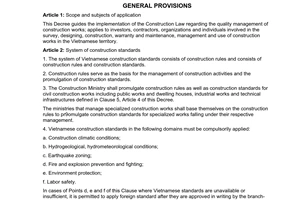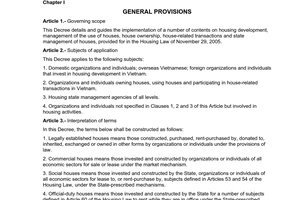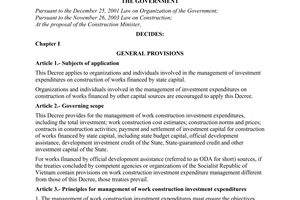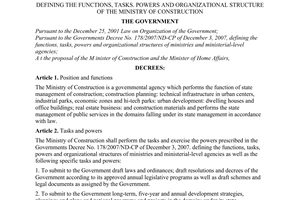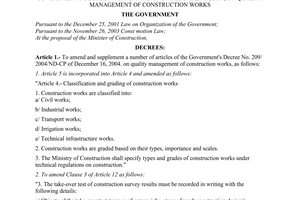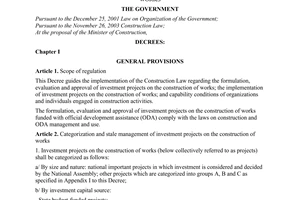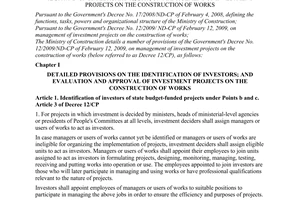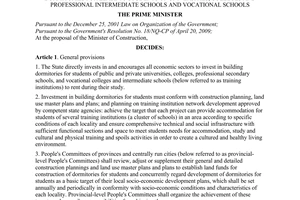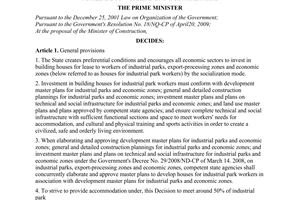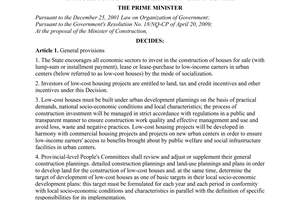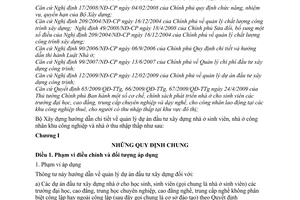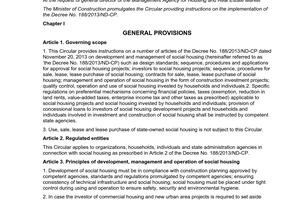Circular No. 10/2009/TT-BXD of June 15, 2009, guiding the management of investment projects to build dormitories for students and houses for industrial park workers and low-income earners đã được thay thế bởi Circular 08/2014/TT-BXD instructions 188/2013/ND-CP development management of social housing và được áp dụng kể từ ngày 08/07/2014.
Nội dung toàn văn Circular No. 10/2009/TT-BXD of June 15, 2009, guiding the management of investment projects to build dormitories for students and houses for industrial park workers and low-income earners
|
THE MINISTRY OF CONSTRUCTION |
SOCIALIST REPUBLIC OF VIETNAM Independence - Freedom
– Happiness |
|
No. 10/2009/TT-BXD |
Hanoi, June 15, 2009 |
CIRCULAR
GUIDING THE MANAGEMENT OF INVESTMENT PROJECTS TO BUILD DORMITORIES FOR STUDENTS AND HOUSES FOR WORKERS IN INDUSTRIAL PARKS AND LOW EARNERS
THE MINISTRY OF CONSTRUCTION
Pursuant to the Government's Decree No. 17/2008/ND-CP on February 4th 2008, defining the functions, tasks and powers of the Ministry of Construction;
Pursuant to the Government's Decree No. 209/2004/ND-CP on December 16th 2004, on management of construction work quality; and the Government's Decree No. 49/2008/ND-CP of April 18, 2008, amending and supplementing a number of articles of the Government's Decree No. 209/2004/ND-CP on December 16th 2004, on management of construction work quality;
Pursuant to the Government's Decree No. 90/2006/ND-CP on September 6th 2006, detailing and guiding the Housing Law;
Pursuant to the Government's Decree No. 99/2007/ND-CP on June 13th 2007, on the management of construction investment expenses;
Pursuant to the Government's Decree No. 12/2009/ND-CP on February 12th 2009, on the management of construction projects;
Pursuant to the Prime Minister's Decisions No. 65/2009/QD-TTg; No. 66/2009/QD-TTg and No. 67/2009/QD-TTg on April 24th 2009, promulgating a number of mechanisms and policies for building dormitories and houses for leasing out to workers in industrial parks and students of universities, colleges and professional secondary and vocational schools, and houses for low earners in urban areas;
The Ministry of Construction guides in detail the management of investment projects to build dormitories for students and houses for workers in industrial parks and low earners as follows:
Chapter I
GENERAL PROVISIONS
Article 1. Scope of regulation and subjects of application
1. Scope of regulation
This Circular guides the management of:
a/ Investment projects to build dormitories for students of public and private universities, colleges, professional secondary schools, and vocational colleges and intermediate schools (below collectively referred to as training institutions) under the Prime Minister's Decision No. 65/2009/QD-TTg of April 24, 2009, promulgating a number of mechanisms and policies to build dormitories for leasing out to students of universities, colleges and professional secondary and vocational schools.
b/ Investment projects to build houses for workers of consolidated industrial parks (including industrial clusters), export-processing zones and economic zones (below collectively referred to as houses for workers in industrial parks) under the Prime Minister's Decision No. 66/ 2009/QD-TTg of April 24, 2009, promulgating a number of mechanisms and policies to build houses for leasing out to workers in industrial parks.
c/ Investment projects to build houses for low earners in urban areas (below referred to as houses for low earners) under the Prime Minister's Decision No. 67/2009/QD-TTg of April 24, 2009, promulgating a number of mechanisms and policies to build houses for low earners in urban areas.
2. Subjects of application
This Circular applies to organizations and individuals investing in house construction and engaged in the elaboration of housing projects specified in Clause 1 of this Article.
Article 2. Identification of project investors 1. Projects to build student dormitories:
a/ State-funded projects:
- Based on characteristics of these projects and local realities, provincial-level People's Committees shall appoint the following agencies to act as their investors:
- Provincial-level Construction Departments or agencies with the construction investment management function, for projects to build consolidated dormitories (including projects to build dormitories for school clusters within the campuses of training institutions).
+ Training institutions, for projects to build dormitories within the campuses of those training institutions.
- Investors of projects to build student dormitories of training institutions under the armed forces shall be decided by managing agencies of those training institutions.
b/ Projects with other funds:
Owners of investment capital of projects to build student dormitories shall act as their investors.
2. Projects to build houses for workers in industrial parks:
a/ Investors to build worker housing infrastructure (grade-I investors):
Investors to deal in industrial park infrastructure may be:
- Local industrial park management units or,
- Industrial park infrastructure enterprises.
b/ Housing project investors (grade-II investors)
Investors of projects to build houses for workers in industrial parks may be:
- Local industrial park management units;
- Industrial park infrastructure enterprises;
- Production enterprises in industrial parks:
- Licensed housing dealers.
3. Projects to build houses for low earners:
Owners of investment capital of projects to build houses for low earners shall act as their investors.
Article 3. Competence to evaluate and decide on project investment
1. Projects to build student dormitories:
a/ State-funded projects:
- Provincial-level People's Committees may decide on investment in state-funded projects to build consolidated dormitories and dormitories within the campuses of training institutions, which are on the list of projects submitted by the Ministry of Construction to the Prime Minister for approval. Provincial-level Planning and Investment Departments shall evaluate these projects.
- Managing agencies of training institutions under the armed forces shall assign their attached units or professional agencies to evaluate projects to build student dormitories of those training institutions before deciding on their investment.
b/ Projects with other funds: Investors shall evaluate and approve these projects.
2. Projects to build houses for workers in industrial parks and low earners:
Investors shall evaluate and approve these projects.
Article 4. Project implementation order
Projects to build student dormitories and houses for workers in industrial parks and low earners shall be implemented in the following order:
1. Investment preparation stage:
a/ Investment deciders identify and appoint investors of housing projects under Article 2 of this Circular.
b/ Investors make a written proposal to provincial-level People's Committees for in-principle approval of investment (except state-funded projects to build student dormitories). The forms of proposal and in-principle approval of investment are in Appendix 1 to this Circular (not printed herein).
c/ Investors formulate and submit construction investment projects to investment deciders for approval.
d/ Investment deciders evaluate and approve projects.
2. Investment stage:
a/ Investors carry out procedures for land allocation or lease to implement projects.
b/ Investors pay ground clearance compensation and clear grounds (if any):
- Provincial-level People's Committees shall pay compensation and clear grounds for projects to build student dormitories and houses for workers of established industrial parks.
- Grade-I investors shall pay compensation and clear grounds for projects to build houses for workers of industrial parks under construction.
- Grade-I investors of projects to build new urban centers or apartment buildings shall pay compensation and clear grounds for projects to build houses for low earners.
c/ Investors select contractors and sign contracts on construction survey and designing.
d/ Contractors conduct construction survey, investors take over construction survey result reports.
e/ Contractors make working drawing designs and cost estimates and submit them to investors for evaluation and approval.
f/ Investors select contractors and sign construction contracts.
g/ Contractors build works.
3. Operation of completed projects:
a/ Investors test projects before take-over and operation.
b/ Investors make and submit investment capital settlements to investment deciders for approval.
c/ Investors elaborate schemes on lease of student dormitories and rents (for non-state funded projects) and rents of houses for workers in industrial parks and submit them to provincial-level People's Committees for approval. Rents of student dormitories built under state-funded projects shall be set by provincial-level People's Committees.
Investors shall elaborate schemes on sale, lease and hire-purchase and house prices under projects to build houses for low earners after they are evaluated by provincial-level People's Committees.
d/ Contractors provide work warranty and operators maintain works.
Chapter II
ELABORATION, EVALUATION AND APPROVAL OF HOUSE CONSTRUCTION INVESTMENT PROJECTS
Article 5. Elaboration of house construction investment projects
1. Basis for project elaboration:
Investors shall elaborate house construction investment projects. When investors are incapable of doing so, they shall hire capable consultants to elaborate house construction investment projects under this Article.
a/ Project classification and grouping:
Projects to build student dormitories and houses for workers in industrial parks and low earners shall be classified and grouped under the Government's Decree No. 12/2009/ ND-CP of February 12, 2009, on management of work construction investment projects,
b/ Student dormitories:
Projects to build student dormitories shall be formulated on the following grounds:
- For state-funded projects: the list of projects under the plan on student dormitories construction already made by the Ministry of Construction and approved by the Prime Minister.
- Construction plannings and plans to build student dormitories of localities, ministries, branches and training institutions.
- Written in-principle investment approval of the provincial-level People's Committee of locality where projects are built (except state-funded projects to build student dormitories).
c/ Houses for workers in industrial parks:
Projects to build houses for workers in industrial parks shall be formulated on the following grounds:
- Local industrial park development planning, urban construction planning and housing development programs.
- Industrial park infrastructure construction planning and development plan.
- Written in-principle investment approval of the provincial-level People's Committee.
d/ Houses for low earners:
Projects to build houses for low earners shall be formulated on the following grounds:
- Local urban construction planning and housing development program.
- Local needs, conditions and characteristics.
- Written in-principle investment approval of the provincial-level People's Committee.
e/ In addition to the grounds specified at Points a. b. c and d of this Clause, projects to build student dormitories and houses for workers in industrial parks and low earners shall be formulated in accordance with regulations, standards, this Circular and other relevant regulations.
2. Project contents: a/ Explanation:
A project explanation must cover the following major contents:
- Grounds for project formulation: To clearly state grounds as guided in Clause 1 of this Article.
- Construction site: To clearly state the project site and location.
- Land use need: To determine the project's land use need based on the construction investment need, construction regulations and standards and this Circular.
- To describe the work construction size and area and work items of the project.
- Solutions:
+ Site clearance plan (if the project site is not yet cleared).
+ Plan on infrastructure construction support (if any): including supports for technical and social infrastructure works.
+ Architectural plan: To state the project's conformity with construction and architecture plannings and landscape of the project area.
+ Plan on project management, operation and use: To specify modes of sale, lease and hirepurchase.
+ Project implementation schedule: To clearly set investment phases and implementation time and schedule of each phase.
+ Project management form: The project to be managed directly by the investor or a hired consultant.
+ Total investment: To be determined under current regulations on management of construction investment expenses (Decree No. 99/2007/ND-CP of June 13. 2007. on management of work construction investment expenses) and other relevant regulations on designing, construction material use norms and capital investment ratios.
- Funds for implementation: To clearly state funding sources: from the central or local state budget: soft loans or capital of the investor.
- Other supports and incentives.
b/ Basic design:
- Explanation:
Explanation of a basic design must cover the following major contents:
+ Description of the project site; locations and sizes of work items; connection of technical infrastructure inside and outside the project area.
+ Designing plan; total ground plan: To apply the construction density and land use coefficient 1.5 times the levels under construction regulations (depending on localities and work construction sites).
+ Living area norms (including axiliary area):
* Student dormitories: minimum 4 m2/ student: maximum 8 students/room.
* Houses for workers in industrial parks: minimum 5 m2/person; maximum 8 persons/ apartment.
* Houses for low earners: maximum 70 m2/apartment.
+ Use coefficient (use area: including living area and areas of other functional sections/ construction floor area) for houses of different categories: from 0.7-0.8.
+ Lists of major designing regulations and standards: To mainly apply domestic standards.
+ To apply standards on domestic medium construction materials.
- Drawings including:
+ Drawing on the project's total ground plan.
+ Drawing on architectural plans of main works.
+ Drawing on connection of technical infrastructure inside and outside the project area.
Article 6. Evaluation of house construction investment projects
1. Investors shall submit project dossiers to persons with investment-deciding competence for evaluation and approval. Such a dossier comprises:
a/ Proposal for project evaluation, made according to the form in Appendix 2 to this Circular (not printed herein);
b/ House construction investment project;
c/ Written in-principle investment approval of the provincial-level People's Committee.
2. The key unit appointed by the investment decider to evaluate projects under Article 3 of this Circular shall evaluate projects and submit evaluation results to the investment decider for approval.
3. When evaluating a project, the key unit shall hold a meeting to obtain a provincial-level Construction Department's opinions on basic design (when the provincial-level Construction Department is the investor, such opinions are not required) and opinions of other agencies in charge of electricity supply, water supply and drainage and fire prevention and fighting. The key unit shall send the project dossier to concerned agencies at least 10 working days before such meeting. Opinions of agencies at the meeting will be official opinions on the project and shall be recorded in writing.
Article 7. Contents of evaluation of house construction investment projects
A key unit's project evaluation covers:
1. Elements to guarantee project feasibility:
a/ Capital sources and capacity to raise funds for the project.
b/ Ground clearance capacity (if ground clearance is required).
c/ Capacity to supply electricity, water, etc.
2. Economic efficiency of the project (except state-funded projects to build student dormitories).
3. Basic design:
a/ Conformity with the construction planning, architecture and landscape of the project area;
b/ Appropriateness of technical infrastructure connection;
c/ Application of designing regulations and standards;
d/ Capability conditions of project formulation and basic design-making consultants.
When a model design is applied, evaluation of basic design is not required.
Article 8. Approval of house construction investment projects
Key units shall submit dossiers of house construction investment projects to persons with investment-deciding competence for approval.
1. A project dossier comprises:
a/ A proposal made according to the form in Appendix 3 to this Circular (not printed herein);
b/ Project dossier and additional documents of the investor (if any) under Article 6 of this Circular;
c/ Minutes of the project evaluation meeting specified in Clause 3, Article 6 of this Circular;
2. Decisions to approve house construction investment projects shall be made according to the form in Appendix 4 to this Circular (not printed herein).
Article 9. Time frames for elaboration, evaluation and approval of house construction investment projects
1. The time for elaborating a state-funded project to build student dormitories is maximum 20 working days.
2. The time for evaluating and approving a house construction investment project is maximum 20 working days after receiving valid dossiers.
Article 10. Elaboration, evaluation and approval of techno-economic reports on houses
1. Elaboration of construction investment projects is not required for houses with a total investment of under VND 15 billion (exclusive of land use levy), for which only techno-economic reports are required.
2. The order to elaborate, contents and evaluation of, and competence to approve, techno-economic reports on house construction investment comply with the Construction Ministry's Circular No. 03/2009/TT-BXD of March 26, 2009, and this Circular.
Chapter III
IMPLEMENTATION OF HOUSE CONSTRUCTION INVESTMENT PROJECTS
Article 11. House construction design
1. Two-step designing, which includes basic and working drawing designing, is required for projects to build student dormitories and houses for workers in industrial parks and low earners.
2. One-step designing, which is working drawing designing, is required for state-funded projects to build student dormitories which apply model designs or works for which only techno-economic reports are required.
3. Investors shall elaborate, evaluate and approve working drawing designs under the Government's Decree No. 12/2009/ND-CP of February 12, 2009, on management of work construction investment projects.
4. The time for making working drawing designs of state-funded projects to build student dormitories is maximum 30 working days.
5. The time for evaluating and approving working drawing designs is maximum 10 working days after receiving valid dossiers.
Article 12. Construction permits
After drawing designs are approved, investors of house construction investment projects under this Circular may start construction without applying for a construction permit, but shall notify such to the local construction management agency at least 7 days before starting construction.
Article 13. Selection of construction consultants and contractors
1. Investors may implement state-funded projects to build student dormitories if they are capable or appoint, negotiate and sign contracts with capable consultancy organizations to formulate projects, make designs, supervise construction, provide supplies and materials and build works.
When contractor designation is applied, the value of the consultancy contract may be reduced by 5% at most; and contracts on equipment and goods supply and construction, by 2% at most compared with the approved cost estimates.
2. Investors may implement projects funded with other sources if they are capable or decide modes to select capable contractors to implement projects.
3. Designation of capable EPC (engineering, procurement and construction) contractors is encouraged.
4. Contract signing: Investors may select modes to sign contracts with contractors to perform jobs of the project on the basis of mutual agreement.
5. The time for carrying out procedures and negotiating for contract signing for state-funded projects which apply contractor designation is maximum 20 working days.
Article 14. Construction management
1. During construction, involved parties shall manage construction quality, volumes and schedules and environmental safety and sanitation under the Construction Law, Decree No. 12/2009/ND-CP Decree No. 209/2004/ND-CP Decree No. 49/2008/ND-CP and relevant guiding documents.
2. Before being put into use, constructed houses must be inspected and certified for quality conformity by capable independent consultancy organizations under regulations.
Article 15. Management of house construction investment expenses
1. The estimation and management of expenses for housing construction investment projects comply with the Government's Decree No. 99/2007/ND-CP of June 13, 2007, on management of work construction investment expenses and guiding documents.
In case of designating EPC contractors to implement state-funded projects to build student dormitories, when negotiating for contract signing, the contract value may be temporarily determined based on the approved total investment. The EPC contract value shall be officially determined based on the cost estimates of works under a project, but must not exceed its approved total investment.
2. The advance and payment for projects comply with law and contractual terms.
3. The settlement of investment capital complies with current regulations.
Article 16. Project management methods
1. When approving projects, investment deciders may decide on their management methods based on the project size and nature and investors' capacity to manage projects.
2. Project management models, functions and tasks of project management units or consultants comply with the Government's Decree No. 12/2009/ND-CP of February 12, 2009, on management of work construction investment projects, and the Construction Ministry's Circular No. 03/2009/TT-BXD of March 26, 2009.
Chapter IV
ORGANIZATION OF IMPLEMENTATION
Article 17. The Ministry of Construction shall:
1. Make a list of state-funded projects to build student dormitories based on reports of ministries, branches and provincial-level People's Committees and submit it to the Prime Minister for approval.
2. Assume the prime responsibility for, and coordinate with ministries, branches and provincial-level People's Committees in, elaborating investment plans to build student dormitories and houses for workers in industrial parks and low earners for the 2009-2015 period and submit them to the Prime Minister for approval.
3. Guide, urge and examine the investment in building dormitories for students and houses for workers in industrial parks and low earners, review their implementation and propose mechanisms to address arising problems to the Prime Minister.
Article 18. Provincial-level People's Committees shall:
1. Elaborate and approve plans to implement projects to build student dormitories of training institutions regardless of their managing agencies, and projects to build houses for workers in industrial parks and low earners in their localities.
2. Direct the implementation of the investment programs to build houses under this Circular in their localities.
3. Quarterly,
biannually and annually report on the implementation and arising problems and
promptly propose their solutions to the Ministry
of Construction for settlement or sum-up for
report to the Prime Minister for settlement.
Article 19. Concerned ministries and branches shall:
1. Elaborate and approve plans to implement projects to build student dormitories of training institutions under their investment competence.
2. Coordinate with provincial-level People's Committees in directing the implementation of projects to build student dormitories of training institutions under their management according to this Circular and relevant legal documents.
3. Biannually and annually report the implementation and arising problems and propose their solutions to the Ministry of Construction for settlement or sum-up for report to the Prime Minister for settlement.
Article 20. Implementation provisions
1. This Circular takes effect on August 1, 2009.
2. Any problems arising from the implementation of this Circular should be reported to the Ministry of Construction for consideration and settlement.
|
|
FOR THE MINISTER OF CONSTRUCTION |
ANNEX 1 (FORM 1)
Enclosed with the Circular No. 10/2009/TT-BXD dated June 15th 2009 of the Ministry of Construction, guiding the management of projects of investment in dormitories for students, houses for workers in industrial parks, and houses for low earners
|
Name of the investor: |
SOCIALIST REPUBLIC OF VIETNAM Independence - Freedom
– Happiness |
APPLICATION FOR THE PERMISSION TO INVEST IN THE CONSTRUCTION PROJECT … [NAME OF THE PROJECT]
To: The People’s Committee of …
Pursuant to ……………………………………………………
1. Name of the investor:
2. Address of the investor:
3. Phone: Fax:
4. Applies for the permission from the People’s Committee of:
5. To invest in: (name of the project)
6. At: (location of the project)
7. Estimated land area:
8. Construction area:
9. Floor area (for each kind of constructions):
10. Scale of the project: (number of rooms, apartments, used area, etc.)
11. Construction density:
12. Land use coefficient:
13. Construction coefficient:
14. Financial capacity, experience in investment and construction management:
15. Other issues:
Requests the People’s Committee of … to permit … (name of the investor) to invest in this project. If the People’s Committee of … permits, … (name of the investor) shall make and send a construction project to competent authorities for appraisal and approval as prescribed.
|
|
(Location and date) The investor (Signature and seal) |
ANNEX 1 (FORM 2)
Enclosed with the Circular No. 10/2009/TT-BXD dated June 15th 2009 of the Ministry of Construction, guiding the management of projects of investment in dormitories for students, houses for workers in industrial parks, and houses for low earners
|
The People’s Committee of … |
SOCIALIST REPUBLIC OF VIETNAM Independence - Freedom
– Happiness |
|
On the permission for the investment |
(Location and date) |
To: (name of the investor)
After considering the Application of …. for the permission to invest in the project ..................
Pursuant to …………………………………
The People’s Committee of ……. permits ….. to make the construction project …………. as follows:
1. Name of the investor:
2. Name of the project:
3. Construction location:
4. Position of project’s land:
5. Project’s land area:
6. Construction area:
7. Construction density:
8. Land use coefficient:
9. Construction coefficient:
10. The criteria and requirements for zoning and architecture:
11. The application of regulations and standards:
12. The buyers and lessees:
13. Total investment:
14. Capital sources
15. Proposals and request:
16. Other issues:
|
|
PP the People’s Committee of … (Signature) |
ANNEX 2
Enclosed with the Circular No. 10/2009/TT-BXD dated June 15th 2009 of the Ministry of Construction, guiding the management of projects of investment in dormitories for students, houses for workers in industrial parks, and houses for low earners
|
Investor |
SOCIALIST REPUBLIC OF VIETNAM Independence - Freedom
– Happiness |
|
No. |
(Location and date) |
APPLICATION FOR THE APPRAISAL AND APPROVAL FOR THE HOUSING CONSTRUCTION PROJECT … (NAME OF PROJECT)
To: (the agency that permits the investment)
- Pursuant to the Government's Decree No. …….… dated … on the management of construction projects;
- Other relevant legal basis;
The investor applies for the appraisal of the housing construction project … (for students, workers, or low earners). In particular:
1. Name of project:
2. Investor:
3. The organization that advises on the project making
4. Person in charge of making the project:
5. Objectives of the construction project:
6. Content and scale of construction:
7. Construction location:
8. Land area:
9. Construction plan (fundamental design):
10. Type and class of construction:
11. Plan for land clearance and resettlement (if any):
12. Total investment in the project:
Total:
Including:
- Construction expenses:
- Equipment expenses:
- Land clearance and resettlement expenses (if any):
- Other expenses:
- Provisionary expenses:
13. Capital sources:
14. The form of sale, lease, hire-purchase:
15. Sale prices, hire-purchase prices, and rents
16. Project management method:
17. Project duration:
18. Incentives and special mechanisms:
19. Other contents:
20. Conclusion:
The investor requests … (the agency that permits the investment) to appraise and approve the construction project ………………….
|
|
Investor (Signature, full name, position, and seal) |
ANNEX 3
Enclosed with the Circular No. 10/2009/TT-BXD dated June 15th 2009 of the Ministry of Construction, guiding the management of projects of investment in dormitories for students, houses for workers in industrial parks, and houses for low earners
|
The appraising agency |
SOCIALIST REPUBLIC OF VIETNAM Independence - Freedom
– Happiness |
|
No. |
(Location and date) |
APPLICATION FOR THE APPROVAL FOR HOUSING CONSTRUCTION PROJECT …… (NAME OF PROJECT)
To: (the agency competent to approve the investment)
(The appraising agency) ……. received the application for the appraisal and approval for the housing construction project (for students, workers, or low earners) No. …… dated ……. of ……..
- Pursuant to the Government's Decree No. ……… dated ………. on the management of construction projects.
- Pursuant to …………………………………
- Pursuant to the Circular No. …………………… of the Minister of Construction.
1. After the appraisal, … (the appraising agency) reports the result of the project appraisals, in particular:
a) Name of project : Type of project: (for students, etc.)
b) Investor:
c) Construction location:
d) Land area:
2. Legality of the application for the appraisal and approval:
a) The basis for making the project:
b) The contractor that advises on the project making:
c) The contractor that creates the fundamental design
d) The contractor conducts the construction survey:
dd) The applicable regulations and standards:
e) The application for the appraisal includes:
g) Relevant legal documents: (Certificate of business registration, handover record, written approval for the investment, minutes of meetings with branches, etc.)
3. Summary of the primary contents of the project: (as in the application for the appraisal and approval for the project of the investor)
4. Summary of opinions from relevant agencies:
5. Remarks and assessments about the project:
a) The necessity and investment objectives:
b) The conformity with the master plan:
c) The conformity with the list of projects approved by the Prime Minister and provincial People’s Committees (if any)
d)Type and class of construction:
dd) The compliance to the applicable construction standards and regulations.
e) The consistency of the design with the Regulations, standards, and this Circular.
g) The conformity of the architecture with master plan for construction, architecture, and scenery approved by competent authorities.
h) The plan for using and running the projects: the plan for sale, lease, hire-purchase, etc.
i) The assessment of environmental impacts, and measures for fire safety
k) Plan for land clearance and resettlement (if any)
l) Total investment, capital source, the capital raise capacity, the repayment plan, applicable to the projects that require capital recovery, and financial targets. Analysis of socio-economic efficiency.
m) The construction duration, the stages, and progress
6. Proposals of investors:
7. The overall assessment of the socio-economic efficiency of the project:
8. The shortcomings of the project; the responsibility and deadline for resolving:
9. Specific proposals:
Requests … (the agency that permits the investment) to consider and approve (or not approve) the project. The investor must be informed whether the project is approved or not approved.
|
|
Head of the agency that appraises the project (Signature and seal) |
ANNEX 4
Enclosed with the Circular No. 10/2009/TT-BXD dated June 15th 2009 of the Ministry of Construction, guiding the management of projects of investment in dormitories for students, houses for workers in industrial parks, and houses for low earners
|
Approving agency |
SOCIALIST REPUBLIC OF VIETNAM Independence - Freedom
– Happiness |
|
No. |
(Location and date) |
DECISION OF … ON THE APPROVAL FOR THE HOUSING CONSTRUCTION PROJECT …………. (NAME OF THE PROJECT)
(Name of the person or agency that gives the approval)
- Pursuant to functions, tasks, and organizational structure of ……………………..;
- Pursuant to the Government's Decree No. ……… dated ………. on the management of construction projects.
- Pursuant to the Circular No. …………………… of the Minister of Construction.
- Pursuant to …………………………………
After considering the Application for the approval for the housing construction project …….. of made by … (the appraising agency) and the report on the appraisal result
Considering the request of …… in the Application No. ………… dated ……………. And the report on the appraisal result of ………………,
DECIDES:
Article 1. Approving the housing construction project …………… with the following primary contents:
1. Name of project:
2. Investor:
3. The organization that advises on the project making
4. Person in charge of making the project:
5. Objectives of construction project:
6. Contents and scale of construction:
7. Construction location:
8. Land area:
9. Construction plan (fundamental design):
10. Type and class of construction:
11. Plan for land clearance and resettlement (if any):
12. Total investment in the project:
Total investment:
Including:
- Construction expenses:
- Equipment expenses:
- Land clearance and resettlement expenses (if any):
- Other expenses:
- Provisionary expenses:
13. Capital sources:
14. Sale prices, hire-purchase prices, rents, etc.
15. Project management method:
16. Project duration:
17. Incentives:
18. Other contents:
Article 2. Implementation organization.
Article 3. Responsibility of relevant agencies for the implementation of this Decision./.
|
|
The approving agency (Signature, full name, position, and seal) |
